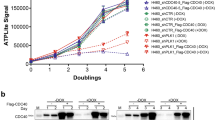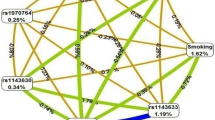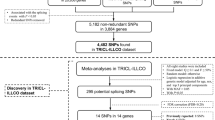Abstract
Cyclin-dependent kinase 5 (CDK5), a proline-directed serine/threonine kinase, which was originally known for its regulatory role in neuronal activities, has recently been suggested to play a role in extraneuronal activities. For example, a recent study detected overexpression of the CDK5 gene in non-small-cell lung cancer. Therefore, in order to explore the association of the CDK5 gene with lung cancer risk in a Korean population, the genotypes of the CDK5 promoter region were determined in 407 lung cancer patients and 402 normal participants. The result showed that the −904 G>A genotype affected susceptibility to lung cancer risk (odd ratios (OR)=1.53, 95% confidence interval (CI)=1.02–2.32). Furthermore, subsequent haplotype analysis of three single-nucleotide polymorphism (SNP) regions suggested that the A–G–C haplotype was associated with a higher overall risk of lung cancer (OR=1.59, 95% CI=1.16–2.18). These results suggest that CDK5 promoter polymorphisms contribute to the genetic susceptibility to lung cancer in the Korean population.
Similar content being viewed by others

Log in or create a free account to read this content
Gain free access to this article, as well as selected content from this journal and more on nature.com
or
Accession codes
References
Lew, J., Beaudette, K., Litwin, C. M. & Wang, J. H. Purification and characterization of a novel proline-directed protein kinase from bovine brain. J. Biol. Chem. 267, 13383–13390 (1992a).
Lew, J., Winkfein, R. J., Paudel, H. K. & Wang, J. H. Brain proline-directed protein kinase is a neurofilament kinase which displays high sequence homology to p34cdc2. J. Biol. Chem. 267, 25922–25926 (1992b).
Chen, F. & Studzinski, G. P. Expression of the neuronal cyclin-dependent kinase 5 activator p35Nck5a in human monocytic cells is associated with differentiation. Blood 97, 3763–3767 (2001).
Tsai, L. H., Takahashi, T., Caviness, V. S. Jr. & Harlow, E. Activity and expression pattern of cyclin-dependent kinase 5 in the embryonic mouse nervous system. Development 119, 1029–1040 (1993).
Chen, F. & Studzinski, G. P. Cyclin-dependent kinase 5 activity enhances monocytic phenotype and cell cycle traverse in 1,25-dihydroxyvitamin D3-treated HL60 cells. Exp. Cell Res. 249, 422–428 (1999).
Chen, F., Wang, Q., Wang, X. & Studzinski, G. P. Up-regulation of Egr1 by 1,25-dihydroxyvitamin D3 contributes to increased expression of p35 activator of cyclin-dependent kinase 5 and consequent onset of the terminal phase of HL60 cell differentiation. Cancer Res. 64, 5425–5433 (2004).
Gao, C. Y., Rampalli, A. M., Cai, H. C., He, H. Y. & Zelenka, P. S. Changes in cyclin dependent kinase expression and activity accompanying lens fiber cell differentiation. Exp. Eye Res. 69, 695–703 (1999).
Lazaro, J. B., Kitzmann, M., Poul, M. A., Vandromme, M., Lamb, N. J. & Fernandez, A. Cyclin dependent kinase 5, cdk5, is a positive regulator of myogenesis in mouse C2 cells. J. Cell Sci. 110 (Pt 10), 1251–1260 (1997).
Lilja, L., Yang, S. N., Webb, D. L., Juntti-Berggren, L., Berggren, P. O. & Bark, C. Cyclin-dependent kinase 5 promotes insulin exocytosis. J. Biol. Chem. 276, 34199–34205 (2001).
Session, D. R., Fautsch, M. P., Avula, R., Jones, W. R., Nehra, A. & Wieben, E. D. Cyclin-dependent kinase 5 is expressed in both Sertoli cells and metaphase spermatocytes. Fertil. Steril. 75, 669–673 (2001).
Studzinski, G. P. & Harrison, J. S. The neuronal cyclin-dependent kinase 5 activator p35Nck5a and Cdk5 activity in monocytic cells. Leuk. Lymphoma 44, 235–240 (2003).
Strock, C. J., Park, J. I., Nakakura, E. K., Bova, G. S., Isaacs, J. T., Ball, D. W. et al. Cyclin-dependent kinase 5 activity controls cell motility and metastatic potential of prostate cancer cells. Cancer Res. 66, 7509–7515 (2006).
Liu, R., Tian, B., Gearing, M., Hunter, S., Ye, K. & Mao, Z. Cdk5-mediated regulation of the PIKE-A-Akt pathway and glioblastoma cell invasion. Proc. Natl Acad. Sci. USA 105, 7570–7575 (2008).
Lin, H., Chen, M. C., Chiu, C. Y., Song, Y. M. & Lin, S. Y. Cdk5 regulates STAT3 activation and cell proliferation in medullary thyroid carcinoma cells. J. Biol. Chem. 282, 2776–2784 (2007).
Sandal, T., Stapnes, C., Kleivdal, H., Hedin, L. & Doskeland, S. O. A novel, extraneuronal role for cyclin-dependent protein kinase 5 (CDK5): modulation of cAMP-induced apoptosis in rat leukemia cells. J. Biol. Chem. 277, 20783–20793 (2002).
Fu, A. K., Fu, W. Y., Ng, A. K., Chien, W. W., Ng, Y. P., Wang, J. H. et al. Cyclin-dependent kinase 5 phosphorylates signal transducer and activator of transcription 3 and regulates its transcriptional activity. Proc. Natl Acad. Sci. USA 101, 6728–6733 (2004).
Lockwood, W. W., Chari, R., Coe, B. P., Girard, L., Macaulay, C., Lam, S. et al. DNA amplification is a ubiquitous mechanism of oncogene activation in lung and other cancers. Oncogene 27, 4615–4624 (2008).
Bogush, A., Pedrini, S., Pelta-Heller, J., Chan, T., Yang, Q., Mao, Z. et al. AKT and CDK5/p35 mediate brain-derived neurotrophic factor induction of DARPP-32 in medium size spiny neurons in vitro. J. Biol. Chem. 282, 7352–7359 (2007).
Cargill, M., Altshuler, D., Ireland, J., Sklar, P., Ardlie, K., Patil, N. et al. Characterization of single-nucleotide polymorphisms in coding regions of human genes. Nat. Genet. 22, 231–238 (1999).
Ramensky, V., Bork, P. & Sunyaev, S. Human non-synonymous SNPs: server and survey. Nucleic Acids Res. 30, 3894–3900 (2002).
Wang, D. G., Fan, J. B., Siao, C. J., Berno, A., Young, P., Sapolsky, R. et al. Large-scale identification, mapping, and genotyping of single-nucleotide polymorphisms in the human genome. Science 280, 1077–1082 (1998).
Sung, J. S., Han, S. G., Whang, Y. M., Shin, E. S., Lee, J. W., Lee, H. J. et al. Putative association of the single nucleotide polymorphisms in RASSF1A promoter with Korean lung cancer. Lung Cancer 61, 301–308 (2008).
Liu, R., Tian, B., Gearing, M., Hunter, S., Ye, K. & Mao, Z. Cdk5-mediated regulation of the PIKE-A-Akt pathway and glioblastoma cell invasion. Proc. Natl Acad. Sci. USA 105, 7570–7575 (2008).
Bader, J. S. The relative power of SNPs and haplotype as genetic markers for association tests. Pharmacogenomics 2, 11–24 (2001).
Choi, J. E., Park, S. H., Kim, K. M., Lee, W. K., Kam, S., Cha, S. I. et al. Polymorphisms in the epidermal growth factor receptor gene and the risk of primary lung cancer: a case-control study. BMC Cancer 7, 199 (2007).
Judson, R. & Stephens, J. C. Notes from the SNP vs haplotype front. Pharmacogenomics 2, 7–10 (2001).
Judson, R., Stephens, J. C. & Windemuth, A. The predictive power of haplotypes in clinical response. Pharmacogenomics 1, 15–26 (2000).
Acknowledgements
We thank Young Lim, Dong-Hoon Shin, Choon-Sik Park and Yangsoo Jang for sample collection and provision. This study was supported by a grant of the Korea Health 21 R&D Project, Ministry of Health & Welfare, Republic of Korea (A010250).
Author information
Authors and Affiliations
Corresponding author
Rights and permissions
About this article
Cite this article
Choi, H., Lee, Y., Park, K. et al. Single-nucleotide polymorphisms in the promoter of the CDK5 gene and lung cancer risk in a Korean population. J Hum Genet 54, 298–303 (2009). https://doi.org/10.1038/jhg.2009.29
Received:
Revised:
Accepted:
Published:
Issue date:
DOI: https://doi.org/10.1038/jhg.2009.29
Keywords
This article is cited by
-
CDK5: an oncogene or an anti-oncogene: location location location
Molecular Cancer (2023)
-
Cyclins and cyclin-dependent kinases: from biology to tumorigenesis and therapeutic opportunities
Journal of Cancer Research and Clinical Oncology (2023)
-
Phosphorylation of a splice variant of collapsin response mediator protein 2 in the nucleus of tumour cells links cyclin dependent kinase-5 to oncogenesis
BMC Cancer (2015)
-
An immunohistochemical study of cyclin-dependent kinase 5 (CDK5) expression in non-small cell lung cancer (NSCLC) and small cell lung cancer (SCLC): a possible prognostic biomarker
World Journal of Surgical Oncology (2015)
-
Expression of CDK5/p35 in resected patients with non-small cell lung cancer: relation to prognosis
Medical Oncology (2011)


